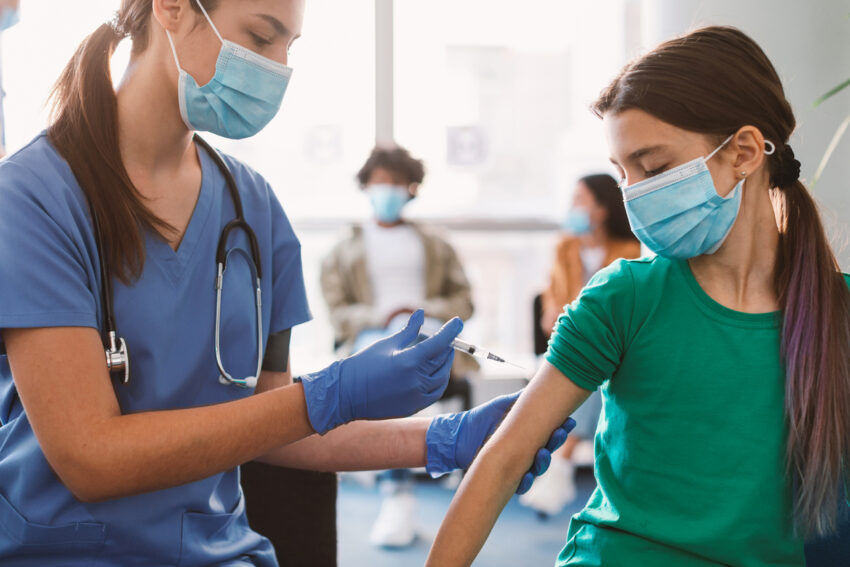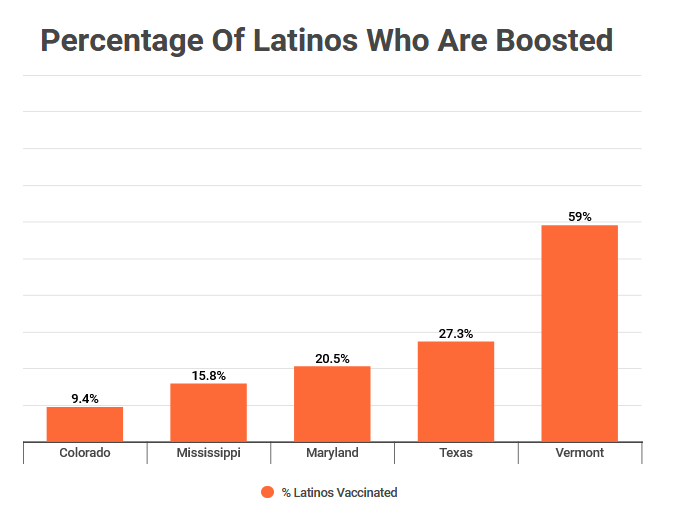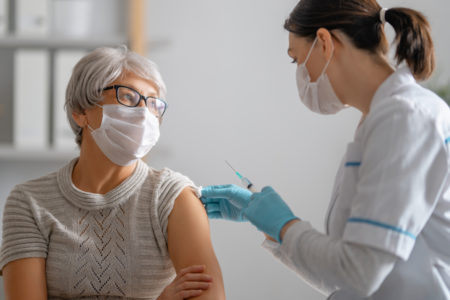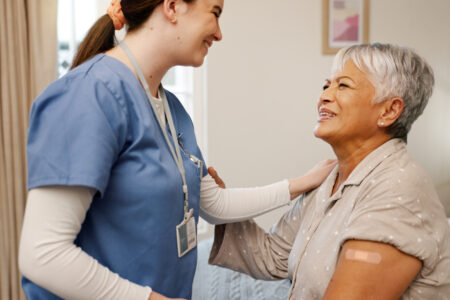
Share On Social!
As the Pfizer-BioNTech, Moderna, and Johnson & Johnson COVID-19 vaccines continue to be distributed across the country, several states are reporting the demographic makeup of their vaccine distribution numbers.
Initially, Latinos made up a very low percentage of those getting a vaccine, despite being hurt more by COVID-19.
However, in the summer and fall of 2021, more and more Latinos got vaccinated, according to data from the Kaiser Family Foundation.
Still, inconsistencies for Latinos persist in different states. Differences in education level, political affiliation, and health insurance also add to the vaccine gap.
As some states begin to release data on booster shots, data shows that Latinos are getting boosted at lower rates compared to other groups.
Let’s take a look at the data.
Find COVID-19 vaccine locations near you in English or Spanish!
UPDATE 3/1/22: Updated numbers for states, including some data on boosters and new data from Kaiser Family Foundation on national Latino vaccination.
COVID-19 Vaccination for Latinos Nationally
As of March 1, 2022, 75% of Latinos have been vaccinated with at least one shot, according to the Kaiser Family Foundation.
This is slightly higher than white people (73%) and Black people (72%).
These numbers suggest that the U.S. is getting closer to eliminating the gap in vaccination.
“While these numbers differ slightly, the weight of these and other recent studies—it’s confirmation we’ve made important progress in increasing vaccination rates and in decreasing vaccination [inconsistencies],” said Dr. Marcella Nunez-Smith, the chair of the White House’s COVID-19 equity task force, according to Newsweek.
However, in some states, the gap in vaccination rate for Latinos continues.
COVID-19 Vaccination for Latinos by State
As of March 1, 2022, 42 out of 50 states report a breakdown of their COVID-19 vaccine distribution numbers that specify Hispanics/Latinos.
Many of these states show that Latinos make up a smaller portion of those getting vaccinated compared to their population proportion in the state.
Some states, like Maine and Vermont, have fully vaccinated their Latino populations, but they have fewer Latinos than other states. Only a few states with large Latino populations, like New Mexico and New Jersey, are among the top states to fully vaccinated their citizens.
In other states with high Latino populations, like Texas, California, and Florida, Latinos make up a third of those vaccinated.
South Dakota
0.4% of vaccinated people are Latino.
4.2% of South Dakota’s population is Latino.
Maine
2% of vaccinated people are Latino.
1.6% of Maine’s population is Latino.
Mississippi
3% of vaccinated people are Latino.
3% of Mississippi’s population is Latino.
New Hampshire
3% of vaccinated people are Latino.
4% of New Hampshire’s population is Latino.
Alaska
5% of vaccinated people are Latino.
5.6% of Alaska’s population is Latino.
South Carolina
5.4% of vaccinated people are Latino.
6% of South Carolina’s population is Latino.
Tennessee
5.3% of vaccinated people are Latino.
5.7% of Tennessee’s population is Latino.
Minnesota
5.4% of vaccinated people are Latino.
5% of Minnesota’s population is Latino.
Louisiana
6.1% of vaccinated people are Latino.
5.3% of Louisiana’s population is Latino.
Indiana
6.8% of vaccinated people are Latino.
6.5% of Indiana’s population is Latino.
Arkansas
8.3% of vaccinated people are Latino.
7% of Arkansas’ population is Latino.
Oregon
9.6% of vaccinated people are Latino.
12% of Oregon’s population is Latino.
Kansas
9.8% of vaccinated people are Latino.
11% of Kansas’ population is Latino.
Maryland
10.4% of vaccinated people are Latino.
9% of Maryland’s population is Latino.
Washington
12% of vaccinated people are Latino.
13% of Washington’s population is Latino.
Illinois
16.4% of vaccinated people are Latino.
17.5% of Illinois’ population is Latino.
New Jersey
17% of vaccinated people are Latino.
20.4% of New Jersey’s population is Latino.
Arizona
19.7% of vaccinated people are Latino.
31.7% of Arizona’s population is Latino.
New York
21.9% of vaccinated people are Latino.
19% of New York’s population is Latino.
Florida
25.2% of vaccinated people are Latino.
27% of Florida’s population is Latino.
Nevada
27.6% of vaccinated people are Latino.
29.2% of Nevada’s population is Latino.
California
31.2% of vaccinated people are Latino.
39% of California’s population is Latino.
Texas
35% of vaccinated people are Latino.
38% of Texas’s population is Latino.
Some states are reporting data that reflects what percentage of the Latino population in that state has received at least one dose of a COVID-19 vaccine.
The following are states that release this data:
Colorado
39.2% of Latinos in Colorado have received at least one dose.
Idaho
42% of Latinos in Idaho have received at least one dose.
Iowa
43% of Latinos in Iowa have received at least one dose.
Alabama
50% of Latinos in Alabama have received at least one dose.
Georgia
55.7% of Latinos in Georgia have received at least one dose.
Wisconsin
56.8% of Latinos in Wisconsin have received at least one dose.
North Carolina
57% of Latinos in North Carolina have received at least one dose.
North Dakota
57.2% of Latinos in North Dakota have received at least one dose.
Ohio
60.3% of Latinos in Ohio have received at least one dose.
Michigan
61.6% of Latinos in Michigan have received at least one dose.
Pennsylvania
62.7% of Latinos in Pennsylvania have received at least one dose.
Utah
64.8% of Latinos in Utah have received at least one dose.
New Mexico
66.2% of Latinos in New Mexico have received at least one dose.
Delaware
69.8% of Latinos in Delaware have received at least one dose.
Missouri
71.8% of Latinos in Missouri have received at least one dose.
Rhode Island
76% of Latinos in Rhode Island have received at least one dose.
Connecticut
76.5% of Latinos in Connecticut have received at least one dose.
Virginia
81% of Latinos in Virginia have received at least one dose.
Vermont
100% of Latinos in Vermont have received at least one dose.
Source: Data from state health department and U.S. Census websites as of March 1, 2022.
Latinos Are Getting Less Booster Shots
Some states have begun reporting data on COVID-19 booster shots. For all races/ethnicities, booster uptake is lower than numbers for first and second doses.
However, Latinos seem to be getting boosted at lower rates compared to their white counterparts.
Alaska
3% of Latinos in Alaska have gotten a booster shot.
Michigan
3.4% of Latinos in Michigan have gotten a booster shot.
Arkansas
4.9% of Latinos in Arkansas have gotten a booster shot.
Colorado
9.4% of Latinos in Colorado have gotten a booster shot.
New Jersey
11% of Latinos in New Jersey have gotten a booster shot.
Illinois
12.1% of Latinos in Illinois have gotten a booster shot.
Pennsylvania
14.3% of Latinos in Pennsylvania have gotten a booster shot.
Delaware
15% of Latinos in Delaware have gotten a booster shot.
Mississippi
15.8% of Latinos in Mississippi have gotten a booster shot.
Wisconsin
17.6% of Latinos in Wisconsin have gotten a booster shot.
Maryland
20.5% of Latinos in Maryland have gotten a booster shot.
Utah
22% of Latinos in Utah have gotten a booster shot.
Virginia
25.4% of Latinos in Virginia have gotten a booster shot.
Oregon
25.8% of Latinos in Oregon have gotten a booster shot.
Texas
25.8% of Latinos in Texas have gotten a booster shot.
Idaho
32% of Latinos in Idaho have gotten a booster shot.
Massachusetts
36% of Latinos in Massachusetts have gotten a booster shot.
Vermont
59% of Latinos in Vermont have gotten a booster shot.
Source: Data from state health department and U.S. Census websites as of March 1, 2022.
Why Are Latinos Getting Vaccinated Less in Some States?
Latinos comprise 18.5% of the U.S. population. And they are being severely impacted by COVID-19.
So why would they make up such a small amount of people getting vaccinated in some states?
Lack of access and vaccine confidence might be the answer.

Most states are following CDC recommendations with vaccine rollout by prioritizing health care workers and elderly people living in assisted living facilities.
However, these overarching groups leave states open to interpret who is defined as a “health care worker,” sometimes leaving out essential workers who are still regularly exposed to COVID-19, such as janitorial and cleaning staff. And often, essential workers and service workers are Latino and Black.
“Those groups were seen and not heard — nobody thought about it,” said Dr. Georges Benjamin, executive director of the American Public Health Association, according to KHN.
Lack of access can also mean fewer vaccination sites in overlooked communities, such as in the greater Boston area.
“In Suffolk County, which includes Boston as well as Chelsea, Revere, and Winthrop, Black and Latino residents face stark [differences] in vaccine access: Fewer than 14 percent of Black residents and roughly 26 percent of Latinos live in census tracts that are within 1 mile of a vaccination site, compared with nearly 46 percent of white residents,” according to the Boston Globe.
With fewer vaccination sites in hard-hit areas, residents are expected to travel across the city to receive a vaccine – an often unrealistic ask for those who can’t afford transportation costs or are unable to take time off from work.
“Once again, we are in the back of the line and we are forgotten and neglected,” said Dinanyili Paulino, chief operating officer of La Colaborativa, a Latino-focused social services organization in the greater Boston area, according to the Boston Globe. “Why should we have to come to Fenway? We are the epicenter. They should come to us … Our members don’t even have 50 cents to ride the bus.”
In New York City, Latinos in hard-hit areas make up a small percentage of those vaccinated.
“Latinos and Blacks represent 16% and 11% respectively of those fully vaccinated in New York City, as compared to 43% of Whites. If you drill down by zip code on the City’s COVID-19 Vaccine Tracker, almost half of the 75 priority zip codes feature abnormally low vaccination rates, with less than 4% fully vaccinated. The estimated 1.6 million people who live in these hard-hit areas aren’t getting what they deserve,” according to New York Daily News.
Other challenges to vaccine access in Latino communities include limited internet access and a lack of bilingual vaccine information.
“Our folks don’t have emails, they don’t have computers at home,” said James Rudyk, executive director of the Northwest Side Housing Center in Chicago, which runs vaccine clinics in Belmont Cragin, a largely Hispanic neighborhood, according to The New York Times. “They have smartphones, but they are not navigating registration systems that want you to fill out pages and pages of information.”
Some clinics serving Latino communities have had to take matters into their own hands.
Gilda Pedraza, the executive director of the Latino Community Fund in Atlanta, helped organized a vaccine clinic for older Latinos before the Georgia state health department posted vaccine information in Spanish, according to The New York Times.
“People didn’t even know that there was a vaccine when we talked to them,” Pedraza said, according to The New York Times.
Lack of vaccine confidence might be another major reason why Latinos are falling behind in vaccination count.
In New York City, Latinos make up 15% of vaccinations despite making up 29% of the city’s population. NYC Mayor Bill de Blasio says hesitancy is part of the problem.
“Clearly, we do see a profound [difference] that needs to be addressed aggressively and creatively,” de Blasio said in a conference call, according to WBOC. “We’ve got a profound problem of distrust and hesitancy, particularly in [overlooked communities].”
A survey conducted by the University of Michigan National Poll on Healthy Aging found that 86% of Latinos said they would not want to receive a vaccine as soon as possible and that 66% of Latinos do not believe the vaccine will be safe.
Latinos may be distrustful of a COVID-19 vaccine because of targeted incorrect information and experiences with involuntary perceptions and mistreatment in the doctor’s office.
“Now, Latinos lag behind in vaccination rates, driven in part by Spanish-language [incorrect information] deliberately targeting us on Facebook, YouTube, WhatsApp and more. The conspiracy forces that tried to depress Latino voter turnout with lies about the election now appear to be using internet platforms to tell Latinos the vaccine contains a microchip, alters DNA or causes stillbirths. The [incorrect information] then spreads through word of mouth,” said author Jean Guerrero, according to the Los Angeles Times.
However, we can help by building trust, empowering Latino community leaders, and making sure the information we share about COVID-19 is accurate and trustworthy.
According to the NIH’s Community Engagement Alliance (CEAL) Against COVID-19 [Differences], some ways to build community trust during the pandemic include invest in long-term relationships with community partners, listen to concerns and learn community insights, acknowledge research challenges and mistakes, and be transparent.
A new study by NIMHD highlights how addressing incorrect information and distrust through academic-community partnerships and creating community-engaged behavioral interventions can effectively address vaccine hesitancy and help promote fair access to Latinos and other people from overlooked communities.
The Biden administration also wants to help bring more vaccines to overlooked communities through the expansion of the federal COVID-19 vaccine program to community health centers across the country.
“Increasing access to vaccines among those hit hardest by the COVID-19 pandemic is critical. By adding to the number of community health centers participating in this program, we will help make sure shots are getting to those who need them most,” Becerra said, according to a press release. “The medical professionals at these local health centers already have trusted relationships in these communities, and this expansion will ensure every community health center in the country can be a part of our vaccination effort.”
California is Allocating Vaccines to Latinos
One state that is taking action to address fairness in vaccine distribution is California.
Governor Gavin Newsom said the state will be begin sending 40% of vaccines to hard hit, predominately Latino neighborhoods, as they have been impacted by COVID-19 the most, according to AP News.
Not only is this plan meant to vaccinate those at highest risk, but also help the state with opening the economy faster.
“It is a [relay] against the variants. It’s a [relay] against exhaustion. It’s a [relay] to safely, thoughtfully open our economy, mindful that it has to be an economy that doesn’t leave people behind,” Newsom said, according to AP News.
This new distribution approach will be helpful for Latinos who have limited access to vaccines, says Dr. Sergio Aguilar-Gaxiola, director of the UC Davis Center for RHD.
“They are living day-to-day, so they have to go and work in order to survive and they don’t have the luxury to take half a day to go where the vaccine sites are,” said Aguilar-Gaxiola, according to AP News.
Some question the ethics of prioritizing vaccination by race rather than risk factors.
“We always say you should do this by risk,” said Georges Benjamin, APHA Executive Director, according to The Nation’s Health. “Because when you do it by [background], you are profiling people, you are [judging] them based on [background]. You are saying, ‘Black people are much more likely to get the disease because they are Black, not because they have situations in which they are much more at risk.’”
In San Diego, COVID-19 hurt the Latino community immensely. While vaccinations started off slowly, they’re beginning to pick up through help of community organizations.
“It took a lot of [health support], education and a lot of outreach,” said Nancy Maldonado, President and CEO of the Chicano Federation, according to CBS. “We’re seeing those numbers start to come up and we’re seeing Latinos are getting vaccinated, but there’s still a lot of work to do.”
They’ve seen vaccine numbers go up with the help of promotoras, healthcare professionals, and community organizers that have helped distribute bilingual vaccine information and combat myths and incorrect information.
In fact, across the country, community health centers have helped make the vaccine more accessible to overlooked communities.
“People [from overlooked communities] represent greater shares of vaccinations at health centers compared to their shares of vaccinations nationally based on data reported by the CDC, especially for Hispanic people. To date, 34% of total first doses administered at health centers have gone to Hispanic people, over two times higher than their share of people who have received one or more doses nationally (14%),” according to the Kaiser Family Foundation.
How Can We Help Latinos During COVID-19?
Find COVID-19 vaccine locations near you in English or Spanish!
One available resource is the Vaccine Toolkit released by Kaiser Permanente. The toolkit offers resources for state and local governments as well as health care organizations to ensure everyone has fair access to the COVID-19 vaccine.
We can also help by sharing accurate information on how to protect one another from COVID-19.
To help move Latinos from vaccine hesitancy to vaccine confidence, Salud America! is uplifting the stories of real Latinos who overcame incorrect information, got the vaccine, reconnected with family, and are helping end the pandemic.
 Share these “change of heart” heroes in English or Spanish!
Share these “change of heart” heroes in English or Spanish!
- Rosa Herrera read on Facebook that the vaccine would inject her with a microchip. She learned that was a myth. See exactly what changed her heart and pushed her to get the vaccine! (en español)
- Jesus Larralde was nervous about the vaccine’s possible side effects. His wife got the vaccine and was fine. See exactly what changed his heart and pushed him to get the vaccine! (en español)
- Helen Cordova thought the vaccine was rushed. But she did her research and learned the vaccine’s safety, and volunteered to be the first person in California to get the vaccine! See exactly what changed her heart! (en español)
Find COVID-19 vaccine locations near you in English or Spanish!
By The Numbers
142
Percent
Expected rise in Latino cancer cases in coming years



